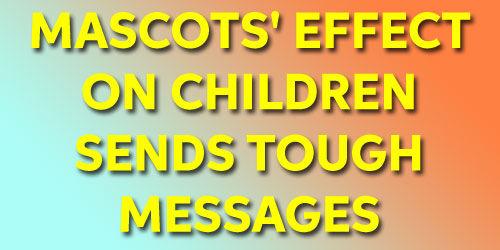Mascots' Effect On Children Sends Tough Messages
- Maria Sen
- Apr 17, 2019
- 3 min read
Updated: Jun 4, 2019

Kids and Mascot Mental Images
Mascots hold a strong mental image for most people that come in touch with one. But mascots effect on children is a lot stronger and serious than with any age group. Youngsters often behave with fondness to mascots that display positive characteristics. A kid could be delighted by the way a mascot dances or any amusing physical activity the mascot partcipates in. This is also true in case a mascot is the embodiment of a product that a youngster wants his / her parents to get for them. Moms and dads are often vulnerable to the marketing industry. This is genuine since many items such as playthings, games, and foods are ordered by parents on behalf of their children. Kids may be very persistent in ensuring that their parents choose the most current cereal or model just because a mascot said it was great. In addition, children that are not but literate may genuinely gravitate towards a mascot. Youngsters at this stage of development search for pictures or symbols that represent familiar what to them.
Mascots as Tough Symbols
Children may be the most sensitive of all age groups to mascots and their symbology. A grown-up may be able to discern if a product or photo that a mascot can be portraying is worthless, while a child could see something very different. Before language skills are strongly produced, children have a tendency to remember events and folks in snapshots like pictures in their memories. Mascot Design Agency might be able to grab a place within a child's mind that'll be vivid and keep meaning up for the child.
Good Vibrations
The positive emotions that mascots elicit from children are often associated with what a mascot does and not simply something itself. Regarding sporting teams the mascots impact on children may be to excite or enthuse them about the team or perhaps a game taking place. Not to mention once again, children may be drawn to the mascot on a personal level. Rather than wanting something lauded by way of a mascot, children might want something that symbolizes the mascot such as a: stuffed pet, shirt, pennant flag, or pin. Mascots in of themselves can be easily marketed to children to promote team sales. As well, the mascot may motivate a new technology of fans being realized by the team.
Mascots, Institutions, and Self-Image
Elementary schools around school campuses heavily use mascots to convey team photograph and assist in promoting team heart. Mascots impact on children may be very strong when dealing with school mascots. Children are exposed to the image typically on a regular basis. The institution mascot could be present over the schools' outside indication or for the wall or ground of the fitness center. Also, young children who play sports may have on uniforms which have the mascots proudly positioned upon them. Children may come to view themselves as getting many of the same characteristics as the mascot should they participate in staff sports. This is why mascots that market a positive impression are very very important to school aged children. Negative mascots impact on children may promote negative pictures of the institution or perhaps perhaps affect a child's self-image.
Responsible Making of Mascots
Since mascots impact on children is deeply profound adults have a responsibility to generate mascots that distribute a warm and good message. They need to keep the best interest of children in mind when designing the costume with the mascot. Also, what on the Mascot Design Cost have become important. The person portraying the mascot comes with an obligation to do something fun and upbeat, while not participating in any behavior which could have a poor or detrimental connotation. This can only help to paint the team or product in a confident light with not only children, but adults as well.



Comments